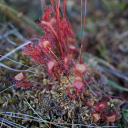Before I came to the Norwegian mountains, I imagined them in a muted palette of grays and browns – heath, tundra, and rock. These were stereotypes, but not ones I found to be groundless after the experiences of a cold and foggy field season, and of hiking to the bare summits of more than a few mountains.
This year I returned during the same season and looked at these landscapes more closely, in places ranging from the mountains of Dovrefjell and Trollheimen to the Arctic coastal ecosystems of Lofoten. With a more careful eye, a full rainbow of colors revealed themselves. They were painted onto the occasional leaf, fruit, and flower, in clear view but on small enough scale to be easily missed.
Here are a few of these species in their autumn aspect.
Salix reticulata (Salicaceae), a small willow whose yellow-tinted leaves stand out against all backgrounds
Vaccinium myrtillus (Ericaceae), the bilberry, with sweet-tasting fruits that leave purple-blue memories on fingers and tongues.
Empetrum nigrum (Ericaceae), the crowberry, a shrub bearing purple-black fruits that remind me of onyx and look far better than they taste – a watery and seedy disappointment.
Eriophorum angustifolium (Cyperaceae), marsh-wool, a marvelous mat-forming sedge whose leaves turn red and whose fruits stream away on long soft white tassels.
Ranunculus glacialis (Ranunculaceae) – a high elevation buttercup whose pale petals rapidly become streaked in pink and purple, and whose flowers seem to persist far longer than any pollinator.
Rubus chamaemorus (Rosaceae) – the cloudberry, a close relative of the raspberry with orange-colored acidic fruits, here unfortunately found in an unripe state.
Drosera rotundifolia (Droseraceae), a carnivorous sundew common in wet areas, with red-purple stems and leaves and glandular hairs.
Comarum palustre (Rosaceae), the marsh cinquefoil, a peat specialist whose orange-red leaves make a beautiful contrast against their mossy habitat.
Chamaepericlymenum suecica (Cornaceae), a bunchberry related to the dogwood tree, with bright-red and bitter-tasting fruits.
Rhodiola rosea (Crassulaceae), king’s crown, with rainbow-colored red-green leaves that have many medicinal uses.
Arctous alpinus (Ericaceae), a dwarf shrub whose prominently-veined leaves turn a brilliant scarlet color.
Although all of these species have circumboreal distributions (occurring at high latitudes around the northern hemisphere), most were almost entirely new to me. Only the Rhodiola and the Drosera occur in the Rocky Mountains I know much better, and there the Drosera is a very rare species restricted to rapidly disappearing habitats. The major factor is probably latitude – some of these Norwegian photographs were taken above 68°N, while my field sites in Colorado are closer to 38°N. The high elevation of the Colorado sites may counterbalance their relatively southern location and allow a few species to extend their ranges that far south.
It is a pleasure to find such bright colors at this time of year. The prevalence of red leaves and fruits is a marked contrast to many North American landscapes that are more dominated by yellow hues. Why should this be? Adaptive explanations have focused on protection from ultraviolet radiation or signaling to other species, but it’s unclear why patterns of redness would be stronger on one continent than another. A better non-adaptive explanation is that it is an artifact of evolutionary history and biogeography. I’ve written about this topic before, but seeing these red colors again after a year away from Europe renewed the pleasure of thinking about this pattern. Mountains are full of surprises.












